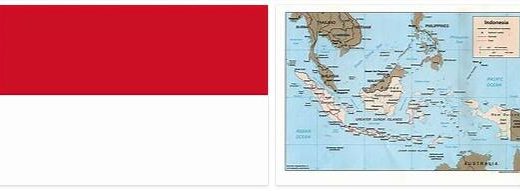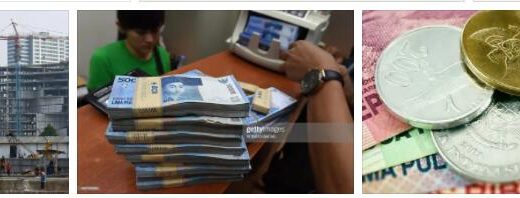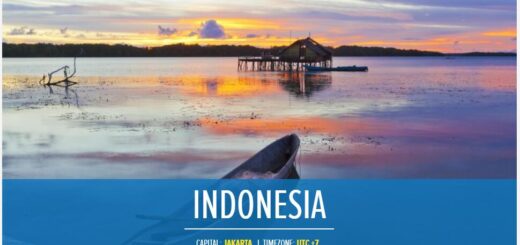Indonesia Economy Overview
Business
The gross national income (GNI) per resident is (2017) US $ 3,540. Despite the wealth of raw materials (especially coal, tin, nickel, copper, bauxite and gold) and the dynamically developing economy, Indonesia is still a developing country, whose financial and economic vulnerability was painfully demonstrated in the Asian currency crisis of 1997/98. In 1998 in particular, there were massive devaluations of the national currency, supply bottlenecks for the population (food) and numerous bankruptcies in the recently booming private sector (e.g. banking and construction). In the meantime, the country has recovered from this slump and shows robust growth rates despite the global economic and financial crisis in 2008/2009 (growth of GDP 2014: 5.0%). It has increasingly developed from a centrally controlled planned economy system to a market economy. The share of agriculture in the gross domestic product (GDP) is (2014) 13.7%; Industry and construction contribute 42.9%, trade and services 43.4%. However, a large part of economic output is generated in the informal sector. The lack of infrastructure and the high level of corruption continue to hinder development.
Foreign trade: The foreign trade balance has been negative for the first time in years since 2012 (import value 2013: US $ 186.6 billion; export value: US $ 182.6 billion). When it comes to exports, crude oil and natural gas, semi-finished goods, machines and mining products dominate. The most important import goods are mineral fuels, machines, chemical products, iron and steel. The most important trading partners include Japan, China, the USA, Singapore, South Korea and Malaysia.
Agriculture
In the agricultural sector (2013) 35% of the workforce are employed. The climate favors agriculture in some parts of the country – such as B. on the island of Java – extraordinary. In Java and Bali, three harvests are possible in two years. The most important crop is rice. Sugar cane, rubber, copra, coffee, aromatic plants, soy, peanuts, tobacco as well as palm kernels and oil are also important agricultural products.
Livestock farming is relatively insignificant in Indonesia in contrast to fishing, which is particularly important for the supply of the local population. The transformation of agriculture (Green Revolution) has contributed to massive restructuring of production methods and the labor market. In the past up to 500 workers per hectare were employed for the rice harvest, today around 10 people are sufficient. The use of high-performance varieties, high levels of fertilizer and pesticide use are just as responsible for this as changes in farm structures. The gradual release of rural labor is an additional burden on the urban labor market, which is already under pressure (internal migration, rural exodus). Capital-intensive large companies result in the over-indebtedness of traditional small companies (land speculation). Nationwide, around 70% of farms are smaller than one hectare.
Forestry: Indonesia has the largest tropical rainforests in the world after Brazil. Of the 162 million ha that still existed in 1950, only about 93.1 million ha are currently left due to extensive clear cutting and devastating forest fires. In the meantime, extensive reforestation programs have been tackled and large-scale clearing has been banned. The majority of the rights to use the forests are in the hands of large private corporations. The most important forestry products are tropical woods, rattan and tree resin.
Natural resources
Although the sharp decline in oil production has made Indonesia a net importer of oil, the country was re-accepted as a member of OPEC at the end of 2015 (until the end of 2016). The main extraction areas are Sumatra, Borneo and Papua. Almost a third of the oil production comes from offshore deposits. In Sumatra, pipelines connect the oil fields with the ports and refineries of Palembang. Most of the natural gas produced is converted into liquid gas. A gas pipeline has been running from the Natuna field to Singapore since 2000, and a second has been running since 2003 from the Grissik field (Riau province) via the Jabung field and the island of Batam to Singapore. When mining tin (on Bangka and Belitung) Indonesia ranks second in the world after China. In 1972, the mining of copper ores began in Papua. In addition, Indonesia is the fourth largest nickel producer in the world. Other mining products are bauxite, coal, gold and silver.
Industry
In the secondary sector (2012) 22.2% of the workforce worked. The manufacturing industry, which has developed increasingly in recent years, is export-oriented and includes mechanical engineering, electronics, oil refineries, paper mills, textile, rubber and chemical plants as well as tobacco processing, rubber processing and the food industry. The locations concentrate on the JABOTABEK (Jakarta, Bogor, Tangerang, Bekasi), Surabaya, Bandung and Medan rooms. There is also an extensive traditional small business. In addition to the widespread weaving and dyeing (batik and ikatte technique), braiding, wood carving, painting, leather processing, gold and silversmithing, ceramics and carpentry are particularly developed branches of handicrafts.
Tourism
With its rich cultural past, the multitude of religious festivals and dance events, important monuments (Buddhist and Hindu temple complexes) and the diverse natural beauties (volcanic landscapes, maritime world), tourism and the associated services are of great importance within the overall economy, albeit mass tourism is only very small. The main destinations of foreign visitors (2012: 8.0 million) are the islands of Bali, Java and Lombok. Visit clothingexpress.org for Indonesia travel package.
Transportation
The inadequate traffic development is one of the greatest infrastructural weaknesses. Rail traffic is limited to Java, Madura and parts of Sumatra (route length 4,684 km). The road network is also densest on Java. Individual parts of Bali, Bangka and Sumatra are also adequately developed in terms of traffic. There is a lack of efficient public transport in metropolitan areas (subway). The rickshaw is still the most common means of transport in the cities. Bus traffic dominates overland traffic. In large parts of Borneo, Celebes and in the lowlands of Sumatra, rivers are still traditional transport routes. Almost three quarters of inland freight traffic is handled by inter-island shipping. There are regular ferry connections between some islands. The most important sea ports are Jakarta, Surabaya, Semarang, Belawan, Palembang and Makassar. International airports are mainly Jakarta, Medan (Sumatra), Denpasar (Bali).



